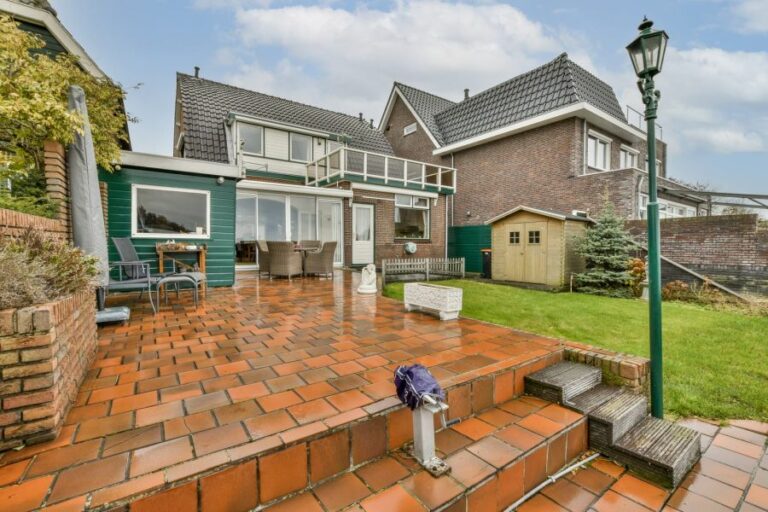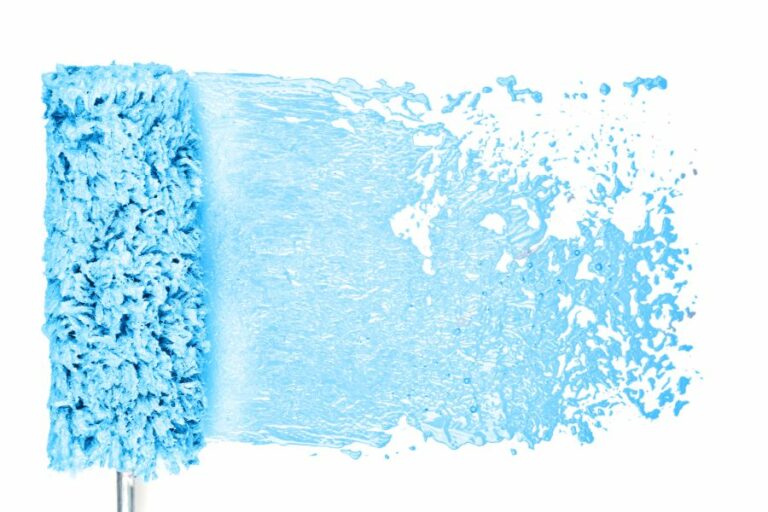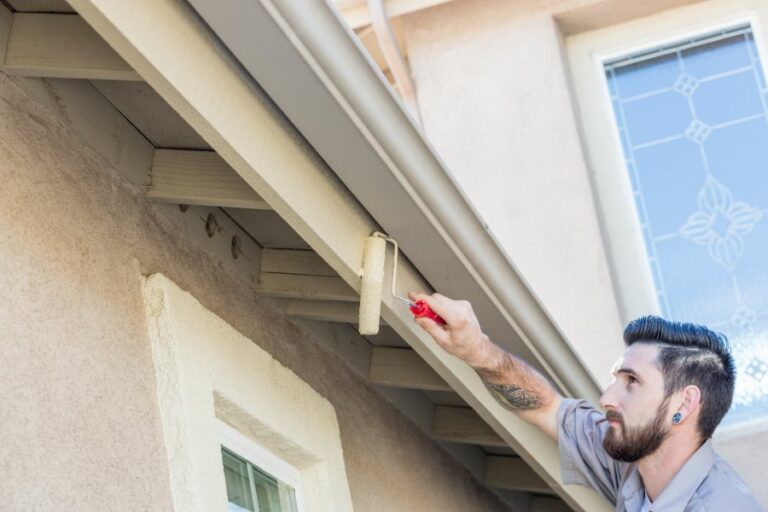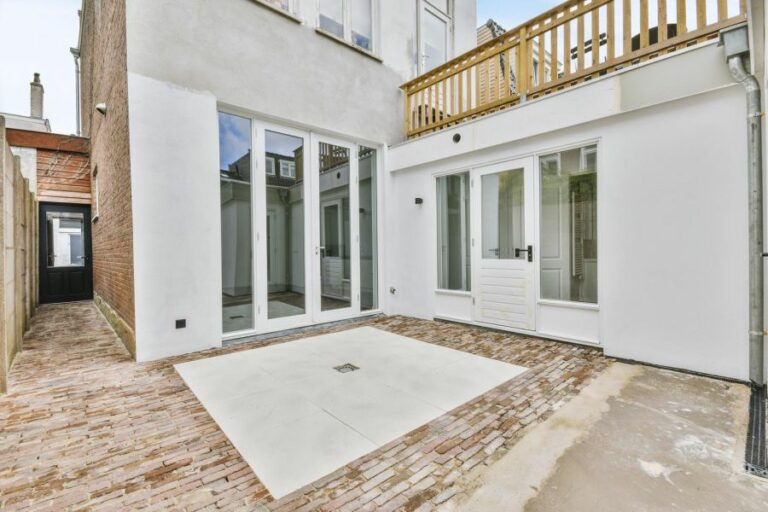Create a Stunning Outdoor Space with These Deck Paint Colors
Are you dreaming of a stunning outdoor deck to enjoy warm summer days and lazy evenings? A perfect deck paint color can brighten your space and elevate its visual appeal. Discover inspiring, transformative deck paint color ideas in our latest blog post!
We’ll showcase versatile shades that can breathe new life into your deck design, complement your outdoor furniture, and reflect your style. Say goodbye to dull, weathered wood and hello to a fresh, captivating space where you can entertain, unwind, and create cherished memories. Let’s get painting!
Outdoor deck paint color ideas:
An outdoor deck serves as a vital living space for relaxation and entertainment, and choosing the perfect paint color can tremendously enhance its appeal. Classic choices like natural wood tones, white, and gray offer timeless appeal, while bold, black, blue, and green options can create a personal statement.
Consider your home’s exterior and outdoor furnishings when selecting a color, and maintain your deck by cleaning, applying protective sealants, addressing damages, and using quality paint to ensure longevity.

Discover stunning outdoor deck paint color ideas to transform your backyard oasis. Be inspired by trending hues and timeless classics, or create a custom color scheme to enhance your home’s unique aesthetic. Dive into limitless possibilities and elevate your outdoor living experience.
Contents
- 1 Outdoor Deck Painting: Color Ideas and Inspiration for Exterior Decking
- 2 What is the Most Suitable Color for an Exterior Deck?
- 3 What is the most prevalent color choice for a deck?
- 4 Determining the Superior Choice for an Outdoor Deck: Staining or Painting?
- 5 What is the appropriate color for painting my deck if the exterior of my house is light gray?
- 6 What Shade Should be Used to Paint a Deck to Conceal Dirt Effectively?
Outdoor Deck Painting: Color Ideas and Inspiration for Exterior Decking
Your home’s deck is an essential outdoor living space, providing a place to relax and entertain guests. Choosing the perfect paint color is one of the easiest ways to give your deck a makeover and enhance its appeal.
This comprehensive guide provides insights into popular paint colors, choosing the right color for your deck, and tips for maintaining and painting your deck.
• Classic and Timeless Paint Colors
Certain outdoor deck paint colors will always be in style due to their timeless appeal. These classic colors can be a safe choice if you want something that will stand the test of time.
– 1. Natural Wood Tones
A natural wood finish is always a great choice for an outdoor deck, as it helps maintain the material’s original beauty. Whether you have a cedar, redwood, or pressure-treated wood deck, staining it with a clear, semi-transparent, or slightly tinted finish can enhance the wood grain and keep it looking fresh for years.
– 2. White
There’s a reason white has always been a classic color choice for outdoor decks. It is clean and crisp and can brighten up your entire outdoor space. White is incredibly versatile, so pairing your white deck with any other color accents or furniture is easy.
– 3. Gray
Another popular color choice for decks is gray, available in various shades from light, soft gray to deep, rich slate. Gray can provide a modern and sophisticated look while offering the versatility to pair well with other colors.
• Bold and Vibrant Paint Colors
If you feel adventurous, choosing a bold and vibrant paint color for your deck can make a strong statement and express your style.
– 4. Black
Black can be an unexpected but stunning choice for an outdoor deck. While black may absorb and retain heat, it can create a sleek, modern look that provides an excellent canvas for colorful outdoor furniture and accessories.
– 5. Blue
Blue is a popular color choice for outdoor spaces due to its calming and soothing effect. From sky blue to navy or a deep ocean hue, blue can create a relaxing atmosphere perfect for entertaining or lounging on your deck.
– 6. Green
A green deck can blend seamlessly into your backyard, creating a feeling of serenity and closeness to nature. From light sage to deep forest green, this versatile color can add a natural touch to your outdoor space.
• Tips for Choosing the Right Paint Color for Your Deck
When deciding on a paint color for your outdoor deck, consider the following tips:
- Consider your home’s exterior: Your deck color should complement your home’s exterior, including the siding, trim, and other architectural elements. A cohesive design can vastly improve your home’s curb appeal.
- Think about your outdoor furnishings: Your deck paint color should work well with your existing outdoor furniture and accessories. Consider your outdoor furniture’s style, materials, and colors when selecting a paint color.
- Use color swatches: Paint swatches can be helpful when determining how a particular color will look in your outdoor space. You can also use online color visualizer tools to see how the paint color will look on your deck.
• Tips for Maintaining and Painting Your Deck
To ensure that your deck remains beautiful and well-maintained, follow these tips:
- Regularly clean your deck: Sweeping and washing your deck can keep it looking its best and extend the life of the paint or stain.
- Apply a protective sealant: A water-repellent sealant can provide an extra layer of protection against the elements and help your paint or stain last longer.
- Check for damage: Any signs of damage, such as splintering or cracking, should be addressed promptly to maintain your deck’s structural integrity and appearance.
- Properly prep the surface: Ensure the deck is correctly prepared before painting. This includes cleaning, sanding, and priming the surface to ensure the paint adheres correctly.
- Choose quality paint: Investing in high-quality deck paint can help ensure that the color lasts longer and provides better protection for your deck.
In conclusion, selecting the right paint color for your outdoor deck can greatly enhance your outdoor living space and add value to your home. Consider classic and bold color choices, keeping your home’s exterior and outdoor furnishings in mind when selecting. Proper maintenance and painting practices will also help prolong the life of your deck and keep it looking fresh for years to come.
Color Name | Color Code | Description |
|---|---|---|
Classic Gray | #D3D3D3 | A timeless, neutral shade that complements a variety of outdoor settings. |
Forest Green | #228B22 | A deep, rich green that evokes the beauty of the natural world. |
Navy Blue | #000080 | A bold, regal shade of blue that adds a touch of sophistication to any outdoor space. |
Chocolate Brown | #8B4513 | A warm, earthy brown that blends seamlessly with the surrounding environment. |
Redwood | #A52A2A | A rich, rustic red that captures the essence of the great outdoors. |
Tan | #D2B48C | A versatile, neutral shade that pairs well with a variety of outdoor furniture and accessories. |
Charcoal | #36454F | An elegant, dark gray that adds depth and drama to any outdoor space. |
Barn Red | #7C0A02 | A vibrant, rustic red that adds a pop of color to your outdoor deck. |
What is the Most Suitable Color for an Exterior Deck?
It is no secret that an attractive and well-maintained outdoor space can greatly increase the value and enjoyment of your home. One critical component of this is the color choice for your outside deck. Selecting the perfect color may seem daunting with so many options and factors.
We will explore key considerations and top recommendations for choosing the best color for your outside deck.
• Factors to Consider Before Choosing a Deck Color
– Home’s Exterior Color Palette and Style
Your deck should complement and enhance the overall appearance of your home. A good starting point is to consider your home’s exterior color palette and architectural style. Strive for a visual balance where the deck color harmonizes with the other colors found on the exterior, such as siding, trim, shutters, and the roof.
Coordinating or contrasting colors can create a uniform or visually striking effect depending on the desired outcome.
– Surrounding Landscape and Environment
Considering the surrounding landscape and environment can contribute to the deck’s aesthetic and help you choose a color that blends seamlessly. Greens and browns often blend well with natural surroundings, while blues and grays may complement outdoor pools or waterfront settings.
Remember that lighter colors show dirt, debris, and stains more readily than darker ones.
– Sun Exposure and Heat Retention
Sun exposure plays into color choice in two significant ways: UV resistance and heat retention. UV-resistant deck colors will fade less over time, maintaining their original appearance longer. Generally, lighter colors are more UV-resistant than darker ones.
Heat retention often depends on color too. Darker colors absorb more heat and can become uncomfortable walking on in direct sunlight. If your deck receives a lot of sun exposure, it’s wise to consider lighter colors to keep the surface cooler.
– Deck Material and Maintenance Requirements
Deck color options will also depend on the material used to build the deck, such as wood, composite, or PVC. While natural wood allows for a wider range of stains and paint colors, composite and PVC materials often come pre-colored with limited options.
Furthermore, consider the ease of application and maintenance requirements before committing to a particular color.
• Top Colors and Recommendations for Your Outside Deck
– Natural Wood Tones
Natural wood tones are popular for traditionalists or those seeking a classic, timeless aesthetic. Stains ranging from light cedar to reddish-brown mahogany can enhance the beauty of the wood grain while offering protection from the elements.
I recommend semi-solid or semi-transparent stains for a rich, natural appearance. Brands like Sherwin-Williams and Benjamin Moore offer numerous stain options. However, regular maintenance, such as reapplying the stain every few years, is necessary to keep the wood looking its best.
– Grays
Gray shades, from light silver to darker charcoal, have become increasingly popular for deck colors in recent years. Grays can provide a modern, sophisticated look that complements other contemporary design elements on your property.
For a sleek appearance, I recommend a solid or semi-solid stain in a shade that complements your home’s color palette.
– Blues and Greens
When seeking a color that harmonizes with the natural surroundings, shades of blues and greens are excellent options. Both can create a tranquil feel while blending seamlessly with your outdoor space’s plants, grass, and water features.
Combining these colors with a muted gray, beige, or taupe can provide a beautiful contrast.
– Dark Browns and Chocolate Tones
Dark browns and chocolate tones create a striking, bold contrast with light-colored siding while blending well with natural elements such as stone or brick.
These colors can add richness and depth to your outdoor space but be cautious of potential heat retention if the deck receives a lot of sun exposure.
• Finding Your Perfect Deck Color
In conclusion, the best color for your outside deck will depend on various factors, including your home’s exterior color palette and style, the surrounding landscape, sun exposure, and the type of deck material.
By considering these factors and exploring the recommendations provided, you’ll be well-positioned to select the perfect deck color that enhances your home’s beauty and the enjoyment of your outdoor space.
Rank | Color |
|---|---|
1 | Natural wood |
2 | Gray |
3 | Brown |
4 | Green |
5 | Blue |
What is the most prevalent color choice for a deck?
When designing and constructing a deck, choosing the right color for your deck is an essential aspect of the overall aesthetic and function of the space. We will explore the most popular deck color options to help you make an informed decision based on your preferences, design style, and the overall theme of your outdoor living area.
• Examining Different Deck Material Options
Before delving into popular deck color options, it’s crucial to consider the material you plan to use for your deck. The most common materials utilized for constructing decks include wood, composite, and PVC. Each material offers a variety of color options that can enhance the overall look and feel of your outdoor space.
– Classic Wooden Decks
Wooden decks are one of the most traditional and popular choices for homeowners because they provide a natural, warm aesthetic that complements various outdoor environments. Common wood species for decking include cedar, redwood, and pressure-treated pine.
These wood types offer a range of color tones, from rich reddish-browns to lighter tans and yellows.
I recommend considering the following popular wooden deck colors:
- Natural Wood: A clear or lightly toned stain will showcase the wood’s natural beauty and grain patterns. This color choice is ideal for maintaining a more traditional, rustic atmosphere.
- Red-toned Brown: This rich, warm shade complements most outdoor environments and is an excellent option for creating a cozy deck atmosphere.
- Grey: A light or dark grey stain can provide a more modern and neutral look to your wooden deck, allowing other outdoor design elements to take center stage.
– Composite Decking
Composite decking has become increasingly popular due to its low maintenance and durability. This material is composed of a combination of wood fibers and plastic, providing a wood-like appearance while requiring less upkeep.
Composite decking is available in an extensive array of color options, making it a versatile choice for homeowners.
Some popular composite deck colors to consider include:
- Brown: Shades of brown, from light to dark and everything in between, offer a traditional, cozy aesthetic for your deck.
- Grey: Grey composite decking can give your outdoor space a contemporary look, allowing you to experiment with different accent colors and design elements.
- Natural Wood Tones: Many composite deck brands offer options that mimic the appearance of natural wood, complete with realistic grain patterns and color variations.
– PVC Decking
PVC is another low-maintenance decking material that has gained popularity in recent years. It is composed entirely of synthetic materials, making it resistant to moisture, rot, and insects. While not as extensive as composite decking, PVC offers various color options to suit various design preferences.
Popular deck colors for PVC include:
- White: A white PVC deck creates a clean, crisp, coastal, or contemporary design style look.
- Earthy Tones: Many PVC deck brands offer a range of brown and grey tones designed to mimic natural wood and offer a more traditional appearance.
- Bold Colors: Some homeowners prefer a pop of color, and certain PVC brands offer striking shades of blue, red, and even black to make a statement with their deck design.
• Factors to Consider When Choosing a Deck Color
When selecting the most popular color for a deck, it is essential to consider several factors that can influence your decision. These factors include:
– Maintenance
Darker colors show dirt and debris more quickly than lighter shades, requiring frequent cleaning to maintain their appearance. If you prefer a low-maintenance option, consider lighter colors or materials resistant to staining.
– Climate
Darker-colored decks may become too hot to walk on during peak daytime hours in areas with intense sunlight. Consider lighter shades or materials with built-in UV protection to keep your deck surface cool and comfortable.
– Coordinating with Your Home’s Exterior
Regardless of the color and material you choose, it’s essential to ensure that it complements the exterior of your home. This includes matching or coordinating with your home’s siding, trim, and other outdoor design elements.
• Final Thoughts
In conclusion, the most popular color for a deck is subjective and depends on various factors, such as the desired aesthetic, material choice, and surrounding environment.
By considering your preferences, design style, and deck material, you can successfully choose the perfect deck color to enhance your outdoor living space.
Determining the Superior Choice for an Outdoor Deck: Staining or Painting?
Choosing the right finishing product is essential for the long-term protection and visual appeal of your outdoor deck. We will discuss the pros and cons of staining and painting an outdoor deck and provide recommendations based on our experience.
• The Advantages and Disadvantages of Staining Your Outdoor Deck
– Benefits of Staining
Enhances the Natural Beauty of Wood
One of the primary benefits of staining your deck is that it enhances the natural beauty of the wood. Stain allows the wood’s grain, texture, and color to show through. As a result, your deck will have a more natural and aesthetically pleasing appearance.
Easy to Apply and Maintain
Staining a deck is often considered quicker and easier than painting. Stain can be applied with a brush, roller, or sprayer and typically requires less preparation than paint. Additionally, staining requires less maintenance than paint. Generally, it just needs to be redone every two to three years.
Better Moisture Resistance
Stains are often more moisture-resistant than paints, allowing the wood to breathe. This means your deck will be less susceptible to water damage and have a longer lifespan.
Slip-Resistance
Staining a deck can also provide better slip resistance than paint. This is because the stain penetrates the wood, maintaining the natural texture of the surface. This is particularly important if you live in a wet climate or your deck is around a pool.
– Disadvantages of Staining
Limited Color Options
One of the key drawbacks of staining is that you will be limited in your color choices. Stains typically come in a restricted range of shades, largely determined by the natural color of the wood.
Less UV Protection
Compared to paint, stains provide less UV protection. Therefore, you might need to reapply the stain more frequently, especially in areas with more sunlight.
Less Durable in High-Traffic Areas
Stains might not be as durable as paint in high-traffic areas, as they are less resistant to wear and tear. This could mean your deck will require more frequent maintenance, especially in areas that experience heavy footfall.
• The Advantages and Disadvantages of Painting Your Outdoor Deck
– Benefits of Painting
Wide Range of Color Options
One of the main advantages of painting your deck is the endless color options available. You can choose any color, making it easy to find the perfect match for your home’s exterior and create a unique, personalized look.
Better UV Protection
Paint provides better UV protection than stains, meaning your deck’s color will be less likely to fade. In addition, paint offers a more even protection distribution, covering the entire wood surface.
Increased Durability
Paint is generally more durable than stain, making it an excellent choice for high-traffic areas. A painted deck can withstand daily wear and tear better and may not require maintenance as frequently as a stained deck.
– Disadvantages of Painting
Hiding the Natural Beauty of Wood
One of the major drawbacks of painting your deck is that it covers the natural beauty of the wood. If you love the look of your deck’s natural grain and texture, painting might not be your best option.
More Labor-Intensive
Painting a deck can be more labor-intensive than staining it. It often requires more preparation, including sanding, priming, and potentially multiple coats of paint. Additionally, paint can chip, peel, or bubble, requiring extensive maintenance than staining.
Less Moisture Resistance
While paint offers better UV protection, it is generally less moisture-resistant than stains. Paint forms a solid barrier on the wood, which can trap moisture and lead to rot and other damage over time.
• Which is Better: Staining or Painting?
There isn’t a one-size-fits-all answer to whether staining or painting an outdoor deck is better. Each option has merits and drawbacks, depending on your priorities and preferences.
If you value wood’s natural beauty and texture and prefer a finish that is easier to apply and maintain, then staining might be your best choice. On the other hand, painting your deck could be the most suitable option if you want a wider range of color options, better UV protection, and increased durability.
In our experience, we recommend staining for those who wish to preserve the natural look of the wood and require less maintenance. However, painting might be your better choice if you’re looking for a more personalized and durable finish. Ultimately, it’s up to you to weigh the pros and cons of each option and decide which will best meet your needs and aesthetic preferences.
What is the appropriate color for painting my deck if the exterior of my house is light gray?
A well-chosen deck color can enhance the overall aesthetic appeal of your home while providing a comfortable outdoor living space. If you have a light gray house, you may wonder what color you should paint your deck to complement your home’s exterior best. We will discuss some popular color choices, the psychology behind them, and how to ensure a harmonious and inviting result.
• Complementary and Contrasting Colors
When selecting a deck color for a light gray house, it is essential to consider the principles of color theory. One approach is to choose complementary colors that fall opposite each other on the color wheel. This creates a visually appealing contrast that can bring balance to your overall design.
A popular choice for decking is a cool blue tone or a deep navy, which complements light gray perfectly. This pairing creates a soothing and calming effect, perfect for a relaxing outdoor oasis. In addition, the contrast between dark blue and light gray makes the deck stand out, drawing attention to your outdoor living space.
– Earthy Shades
Another option is earthy tones such as beige, taupe, or sand colors. These shades can warm your home’s exterior and create a natural, inviting atmosphere. The soft contrast between the earth tones and light gray can create a harmonious outdoor living space that blends well with the surrounding environment.
• Monochromatic Elegance
Alternatively, you may opt for a monochromatic color scheme, which includes shades that vary in lightness and saturation of the same hue. Choose a deck color for a light gray house that also falls within the gray spectrum. This can lead to a modern and sophisticated look for your home.
– Dark Gray
Dark gray is an excellent choice to maintain the gray theme while still achieving a striking contrast. Dark gray offers a bold, contemporary appearance, and its richness can help anchor the lighter color of your home.
– Soft Gray
You can choose a soft gray slightly darker than your house color for a more subtle and cohesive look. This creates a harmonious flow between your home’s exterior and the deck, seamlessly transitioning between indoor and outdoor living spaces.
• Warm and Inviting Neutrals
Neutral colors offer a versatile and timeless option for your deck. They work well with various house colors, including light gray, and create a welcoming atmosphere that suits any style.
– Warm Brown
A warm brown deck color is a classic choice with light gray siding. The rich, earthy hues bring a sense of coziness and warmth to your outdoor area while complementing the neutral tones of your home. Additionally, brown blends seamlessly with natural surroundings, making it an ideal choice for homeowners who love spending time outdoors.
– Light Tan
A light tan or beige color is another great neutral option that pairs well with light gray houses. This soft, understated color creates an inviting, relaxing outdoor space that maintains visual interest. Furthermore, light tan is an excellent choice if you want to match the color of your deck with other exterior features, such as patio furniture or fencing.
• Bold and Vibrant Choices
For those who dare to make a statement, a bold deck color may be the way to go. While this approach is less conventional, it can lead to a stunning and unique result.
– Red or Burgundy
A red or burgundy deck can create a bold, striking contrast against a light gray house. This vibrant color often evokes passion and energy, making it an exciting choice for homeowners looking to create an inviting and lively outdoor space.
– Green
Green shades can also make a strong visual impact when paired with light gray siding. A deep, rich green creates a sense of lushness and tranquility and echoes the colors of the surrounding landscape.
• Final Thoughts
In conclusion, when selecting the perfect deck color for your light gray house, it is crucial to consider your desired atmosphere, your home’s architectural style, and the surrounding landscape. From complementary and contrasting blues and earthy shades to monochromatic grays, warm and inviting neutrals, and bold, vibrant choices, an array of options suits your needs and preferences. Ultimately, your chosen deck color should enhance your enjoyment of your outdoor living space and add visual appeal to your home’s exterior.
What Shade Should be Used to Paint a Deck to Conceal Dirt Effectively?
A well-maintained and clean deck can significantly enhance the appearance of your outdoor living space. One of the factors to consider when looking for ways to minimize the visibility of dirt on your deck is choosing the right color for the paint. We will discuss the factors to consider when selecting the perfect color for your deck and offer recommendations based on our experience.
• Understanding the Primary Sources of Dirt
Before discussing the paint color options, it is essential to identify the primary sources of dirt on your deck. Generally, dirt on your deck comes from the following sources:
- Foot traffic: People walking over it often bring dirt and debris onto the deck.
- Leaves and organic matter: Leaves, twigs, and other organic materials can fall and accumulate on the deck, especially during the fall season.
- Mildew and algae growth: These organisms can develop on damp or shaded areas of your deck, causing green or black discoloration.
With these primary sources of dirt in mind, we can move on to factors that will influence the color choice for your deck paint.
• Consider the Surrounding Environment
When deciding on a color for your deck, consider the surrounding environment, as it significantly affects the overall look and the visibility of dirt. For instance, if you live in a heavily wooded area with lots of fallen leaves, choosing a deck paint color that blends with the leaf color can help make the dirt less visible.
Here are a few useful tips based on different environmental settings:
– Urban Settings
In urban settings, you might have to deal with dust and dirt from neighboring construction and traffic, which might call for darker colors. Gray shades with brown undertones, dark brown, or charcoal colors can conceal dirt in such environments.
– Wooded Areas
In areas surrounded by trees, consider earth tones, such as different shades of brown that complement the natural surroundings while still helping to hide dirt and fallen leaves.
• Balancing Style and Practicality
Balancing style and practicality when hiding dirt on your deck is essential. You may have a particular color palette in mind, but you might need to make some compromises to ensure that your chosen color will effectively minimize dirt visibility. Here are some style considerations to keep in mind:
– Complementary Colors
Choose paint colors for a visually appealing deck that complements your home’s exterior and landscape. This way, your deck will hide dirt and look cohesive and well-thought-out.
– Neutral Shades
Neutral colors like grays, tans, and browns typically do a good job of hiding dirt. Moreover, they can easily blend in with various surrounding colors and materials.
• Top Color Recommendations to Hide Dirt
Based on the factors mentioned above and from our experience, here are some recommended colors that can effectively conceal dirt on your deck:
- Taupe: This versatile, warm color can complement various environments and hide dirt effectively.
- Slate Gray: The cool undertones of slate gray can help to neutralize dirt and blend well with different home exteriors.
- Dark Brown: This color is ideal for wooded environments and can hide dirt, leaves, and other debris.
• Additional Tips for a Clean Deck
While choosing the right deck paint color is essential for hiding dirt, maintaining a clean deck is also essential. Here are a few quick tips to keep your deck looking its best:
- Regularly sweep your deck to remove dirt, leaves, and other debris.
- Wash your deck with a mild detergent and water, using a soft brush or cloth, at least once a year.
- If you notice mildew or algae growth, clean the affected area with a solution containing 1 part bleach to 4 parts water.
- Consider using a deck sealant after painting to add an extra layer of protection against dirt and stains.
In conclusion, consider factors such as the surrounding environment, color preferences, and the practicality of effectively hiding dirt on your deck. Opt for colors that will complement your home’s exterior, as well as the landscape, and are effective in concealing dirt and debris.
Regular maintenance and the right paint color will ensure your deck remains clean and appealing for years. Don’t be afraid to experiment with different shades to achieve the desired result.







